Birds are some of the most colorful creatures on Earth, with their bright feathers and unique patterns. These colors are not just beautiful to look at, but they also help birds attract mates, blend into their surroundings, or even scare away predators. In this article, we will explore some of the most colorful birds from around the world, each one a vibrant masterpiece of nature.
Top 15 most colorful birds
| Number | Bird Name | Description |
|---|---|---|
| 1 | Scarlet Macaw | A large parrot with vibrant red, blue, and yellow feathers. |
| 2 | Peacock | Known for its stunning blue and green tail feathers that fan out. |
| 3 | Mandarin Duck | A small, colorful duck with a mix of orange, purple, and green. |
| 4 | Gouldian Finch | A tiny bird with bright red, green, and yellow feathers. |
| 5 | Toucan | A bird with a large, colorful beak and black, yellow, and orange feathers. |
| 6 | Lilac-breasted Roller | A bird with blue, purple, and green feathers, often found in Africa. |
| 7 | Resplendent Quetzal | A vibrant bird with green, red, and blue feathers, found in Central America. |
| 8 | Rainbow Lorikeet | A parrot with a mix of blue, green, and red feathers. |
| 9 | Kingfisher | A small bird with bright blue and orange feathers. |
| 10 | American Flamingo | Known for its pink feathers and long legs. |
| 11 | Painted Bunting | A small bird with blue, green, red, and yellow feathers. |
| 12 | Paradise Tanager | A bird with a striking mix of green, blue, and red feathers. |
| 13 | Wilson’s Bird-of-Paradise | A bird with vibrant red, yellow, and blue feathers. |
| 14 | Indian Roller | A bird with blue and brown feathers, known for its acrobatic flight. |
| 15 | Northern Cardinal | A bird with bright red feathers, often found in North America. |
Certainly! Here’s a more detailed and extended article on the Top 15 Most Colorful Birds.
Top 15 Most Colorful Birds Full explaination
Birds are nature’s masterpieces, often flaunting feathers in a stunning array of colors and patterns. From the dense rainforests to the open savannahs, colorful birds capture our imagination with their vibrant plumage. Here’s a closer look at 15 of the most colorful birds around the globe, showcasing their unique beauty and characteristics.
1. Scarlet Macaw
Description
The Scarlet Macaw is a large, striking parrot found in the rainforests of Central and South America. Its vivid red feathers, contrasted by bright blue and yellow wings, make it one of the most eye-catching birds in the world. This macaw is not just a visual spectacle but also a symbol of the tropical rainforests it inhabits.

Appearance
- Color: Predominantly bright red with blue and yellow feathers on the wings and tail.
- Size: Approximately 32 inches (81 cm) in length.
- Beak: The beak is large, curved, and a pale color, adapted for cracking nuts and seeds.
Habitat
Scarlet Macaws thrive in lowland rainforests, especially in the Amazon Basin, as well as in parts of Central America. They prefer dense, tropical forests with abundant fruit and large trees, which offer both food and nesting sites.
Diet
These macaws have a diverse diet consisting mainly of fruits, nuts, and seeds. They also consume small insects and occasionally clay from riverbanks, which helps them digest their food and neutralize toxins from their diet.
Behavior
Scarlet Macaws are highly social and live in large, noisy flocks. They are known for their intelligence and can mimic human speech. Their calls are loud and distinctive, serving as a means of communication within their flocks. They are monogamous, often forming lifelong bonds with a single mate.
Conservation Status
The Scarlet Macaw is listed as Least Concern by the IUCN, but it faces threats from habitat loss and the illegal pet trade. Conservation efforts are focused on preserving their rainforest habitats and controlling illegal trapping.
| Feature | Details |
|---|---|
| Scientific Name | Ara macao |
| Weight | 2.2-3.5 lbs (1-1.6 kg) |
| Wingspan | 34-39 inches (86-99 cm) |
| Length | 32-40 inches (81-102 cm) |
| Beak | Large, curved, and strong |
| Lifespan | 30-40 years in the wild |
2. Peacock
Description
The Peacock, also known as the Indian Peacock or Indian Peafowl, is famed for its extravagant plumage. Native to South Asia, particularly India, this bird’s iridescent tail feathers, known as a “train,” are adorned with eye-catching patterns.

Appearance
- Color: Males exhibit vibrant blues and greens, with their tail feathers featuring large, iridescent eye spots.
- Size: Males can reach up to 6.6 feet (2 meters) including the tail feathers, while females are smaller.
- Tail: The train can extend up to 5 feet (1.5 meters) and is used in courtship displays.
Habitat
Peacocks are typically found in open forests, grasslands, and cultivated areas in India, Sri Lanka, and Southeast Asia. They prefer environments with a mix of open ground and dense cover.
Diet
Their diet includes a variety of seeds, fruits, insects, and small mammals. They are also known to forage for insects and small reptiles, which supplement their diet with protein.
Behavior
Male peacocks are known for their elaborate courtship displays. During mating season, they fan out their tail feathers and perform a dance to attract females. The vibrant tail feathers are used to impress potential mates, with the size and quality of the display being an indicator of the bird’s health and vitality.
Conservation Status
The Indian Peacock is classified as Least Concern by the IUCN. However, habitat loss and hunting pressures can impact local populations. Conservation measures are in place to protect their natural habitats and reduce poaching.
| Feature | Details |
|---|---|
| Scientific Name | Pavo cristatus |
| Weight | 8.8-13.2 lbs (4-6 kg) |
| Wingspan | 60-72 inches (152-183 cm) |
| Length | 60-80 inches (152-203 cm) |
| Beak | Short and strong |
| Lifespan | 15-20 years |
3. Mandarin Duck
Description
The Mandarin Duck, native to East Asia, including China and Japan, is renowned for its elaborate and colorful plumage. This small, but strikingly beautiful duck is often found in wooded lakes and rivers.
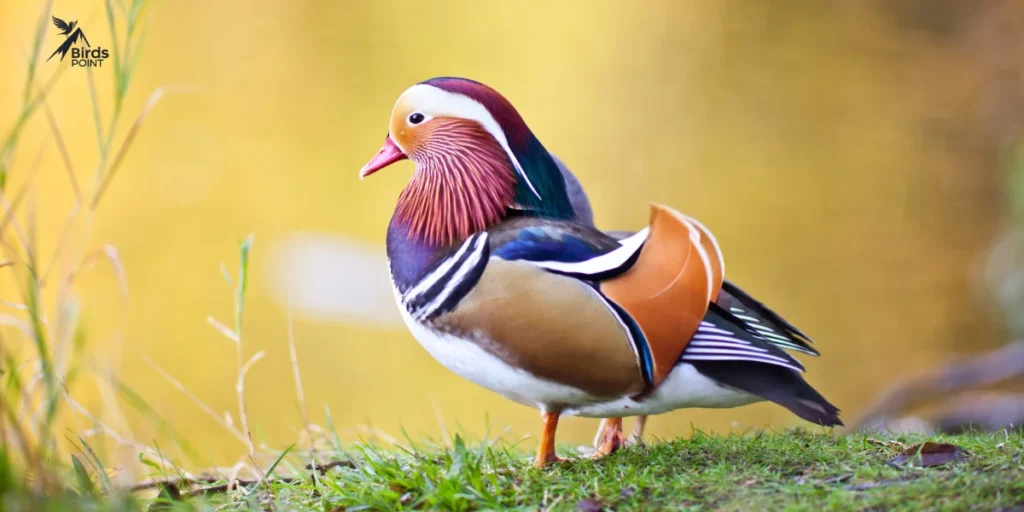
Appearance
- Color: Males display vibrant colors with orange and purple plumage, a green head, and white streaks along the body.
- Size: About 16-21 inches (40-50 cm) in length.
- Beak: The beak is short and orange, complementing the bird’s overall color scheme.
Habitat
Mandarin Ducks inhabit wooded lakes, ponds, and slow-moving rivers. They prefer areas with dense vegetation for nesting and cover.
Diet
Their diet consists of seeds, aquatic plants, and small invertebrates. They are often seen dabbling in the water, foraging for food.
Behavior
Mandarin Ducks are known for their elaborate mating displays, where males showcase their colorful plumage to attract females. They are also known to be quite secretive and are more active during the early morning and late evening.
Conservation Status
The Mandarin Duck is classified as Least Concern by the IUCN. However, habitat destruction and hunting can impact their populations. Conservation efforts focus on preserving their natural habitats and managing hunting pressures.
| Feature | Details |
|---|---|
| Scientific Name | Aix galericulata |
| Weight | 1.1-1.5 lbs (0.5-0.7 kg) |
| Wingspan | 23-26 inches (58-66 cm) |
| Length | 16-19 inches (40-50 cm) |
| Beak | Short and broad |
| Lifespan | 5-10 years |
4. Gouldian Finch
Description
The Gouldian Finch, native to northern Australia, is celebrated for its brilliant and varied colors. This small, finch-like bird is a favorite among bird enthusiasts for its striking appearance.
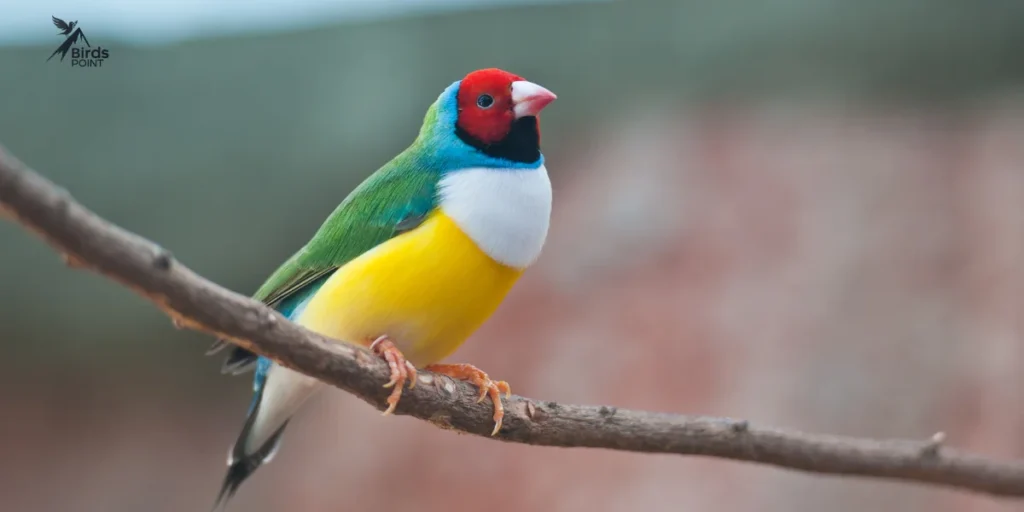
Appearance
- Color: Males have a vibrant mix of green, yellow, red, and purple plumage. Females are less colorful but still display a range of beautiful shades.
- Size: Approximately 4.5 inches (11 cm) in length.
- Beak: The beak is conical and bright red, suited for seed eating.
Habitat
Gouldian Finches are typically found in open woodlands and savannahs. They prefer areas with plenty of grass and scattered trees.
Diet
Their diet mainly consists of seeds, especially grass seeds. They are known to forage in the wild and in captivity, where they thrive on a varied diet.
Behavior
Gouldian Finches are social birds and often form large flocks. They communicate through a variety of calls and are known for their acrobatic flight patterns. They are also popular in aviculture due to their striking appearance and relatively easy care requirements.
Conservation Status
The Gouldian Finch is classified as Endangered by the IUCN. Habitat destruction, changes in fire regimes, and competition with other species have led to a decline in their numbers. Conservation efforts are focused on habitat preservation and breeding programs.
| Feature | Details |
|---|---|
| Scientific Name | Erythrura gouldiae |
| Weight | 0.4-0.5 oz (11-15 g) |
| Wingspan | 6-8 inches (15-20 cm) |
| Length | 4.5-5.5 inches (11-14 cm) |
| Beak | Short and conical |
| Lifespan | 4-8 years |
5. Toucan
Description
Toucans are known for their large, colorful bills and vibrant plumage. Native to Central and South America, these birds are a symbol of the tropical rainforests they inhabit.
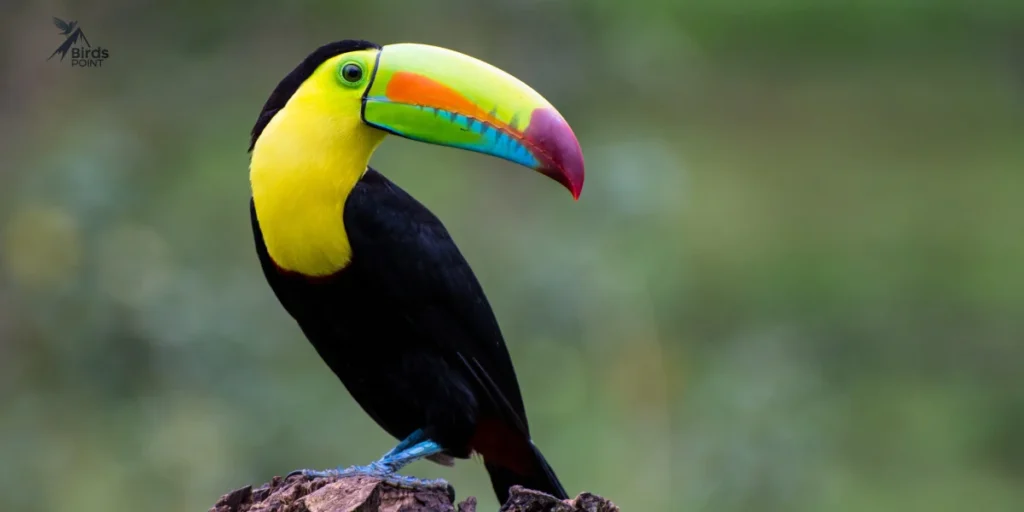
Appearance
- Color: Toucans have a range of bright colors, including yellow, orange, red, and green. Their most distinctive feature is their oversized, colorful bill.
- Size: Sizes vary by species, but they generally range from 18 to 24 inches (46-61 cm) in length.
- Bill: The bill can be up to half the length of the bird’s body and is brightly colored.
Habitat
Toucans are typically found in tropical rainforests and can also be seen in cloud forests. They prefer dense, forested areas with ample fruit and nesting sites.
Diet
Their diet consists primarily of fruits, but they also eat insects, small reptiles, and other small animals. Their large bills are adapted for reaching and manipulating fruit.
Behavior
Toucans are social birds that live in small groups. They are known for their playful behavior and distinctive calls. Their large bills are not only colorful but also functional for reaching fruit and attracting mates.
Conservation Status
The conservation status of toucans varies by species. Many are classified as Least Concern, but habitat destruction and hunting pose threats. Conservation efforts focus on protecting their rainforest habitats and reducing the impact of human activities.
| Feature | Details |
|---|---|
| Scientific Name | Ramphastos toco |
| Weight | 1.2-2.2 lbs (0.55-1 kg) |
| Wingspan | 15-20 inches (38-50 cm) |
| Length | 18-24 inches (46-61 cm) |
| Beak | Large, curved, and colorful |
| Lifespan | 15-20 years |
6. Lilac-breasted Roller
Description
The Lilac-breasted Roller is a vibrant bird native to Africa. Its plumage displays a spectacular mix of colors, making it one of the most colorful birds on the continent.

Appearance
- Color: This bird features a lilac breast, turquoise-blue back, and green wings. Its tail feathers are long and adorned with bright colors.
- Size: About 14-16 inches (35-40 cm) in length.
- Beak: The beak is short and robust, suitable for catching insects.
Habitat
Lilac-breasted Rollers are found in open woodlands, savannahs, and grasslands across sub-Saharan Africa. They prefer areas with scattered trees and open spaces.
Diet
Their diet includes a variety of insects, small reptiles, and occasionally small mammals. They are known for their hunting skills and aerial acrobatics.
Behavior
These rollers are often seen perched on exposed branches, where they scan for prey. They are known for their spectacular aerial displays, which include rolling and tumbling in the air.
Conservation Status
The Lilac-breasted Roller is classified as Least Concern by the IUCN. While habitat loss poses a threat, their adaptable nature helps them thrive in a range of environments.
| Feature | Details |
|---|---|
| Scientific Name | Coracias caudata |
| Weight | 4.2-6.3 oz (120-180 g) |
| Wingspan | 16-18 inches (40-46 cm) |
| Length | 12-14 inches (30-36 cm) |
| Beak | Short and strong |
| Lifespan | 10-15 years |
7. Resplendent Quetzal
Description
The Resplendent Quetzal is a strikingly beautiful bird native to Central America. Its vibrant green and red plumage, along with its long tail feathers, make it a symbol of the tropical rainforests.
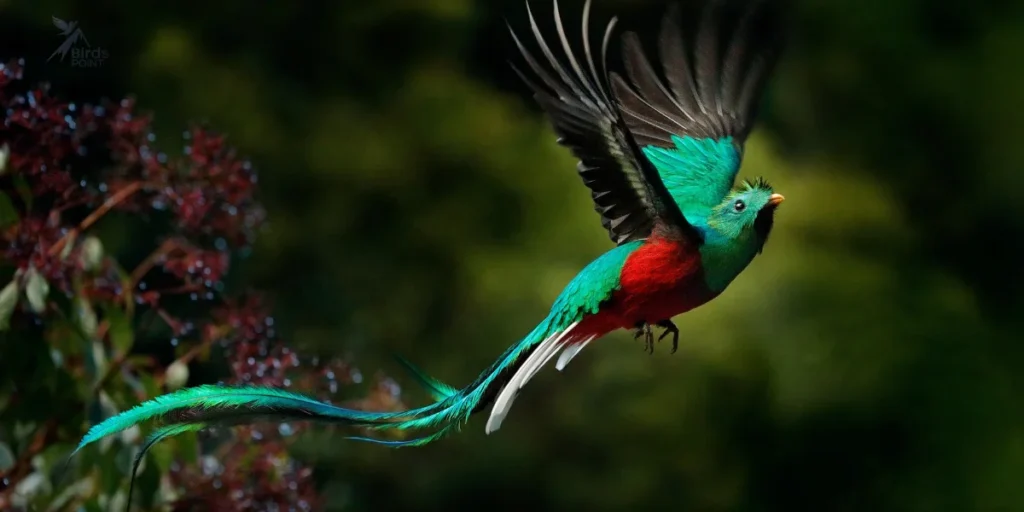
Appearance
- Color: Males have bright green plumage with a red belly and long, iridescent tail feathers.
- Size: About 14-16 inches (35-40 cm) in body length, with tail feathers extending up to 24 inches (60 cm).
- Beak: The beak is short and hooked, adapted for feeding on fruits and insects.
Habitat
Resplendent Quetzals inhabit cloud forests and highland rainforests in countries like Guatemala, Costa Rica, and Honduras. They prefer dense, moist forests with abundant fruit.
Diet
Their diet mainly consists of fruits, especially wild avocados and berries. They also eat insects and small invertebrates.
Behavior
These quetzals are known for their elusive behavior and beautiful calls. They are solitary or found in small groups and are renowned for their long, flowing tail feathers, which are used in mating displays.
Conservation Status
The Resplendent Quetzal is classified as Near Threatened by the IUCN. Habitat destruction and deforestation pose significant threats. Conservation efforts focus on protecting their cloud forest habitats and reducing deforestation.
| Feature | Details |
|---|---|
| Scientific Name | Pharomachrus mocinno |
| Weight | 6.3-8.8 oz (180-250 g) |
| Wingspan | 20-24 inches (50-60 cm) |
| Length | 14-26 inches (35-65 cm) |
| Beak | Short and hooked |
| Lifespan | 15-20 years |
8. Rainbow Lorikeet
Description
The Rainbow Lorikeet is a small, brightly colored parrot native to Australia and surrounding islands. Its vibrant plumage and playful behavior make it a favorite among bird watchers.
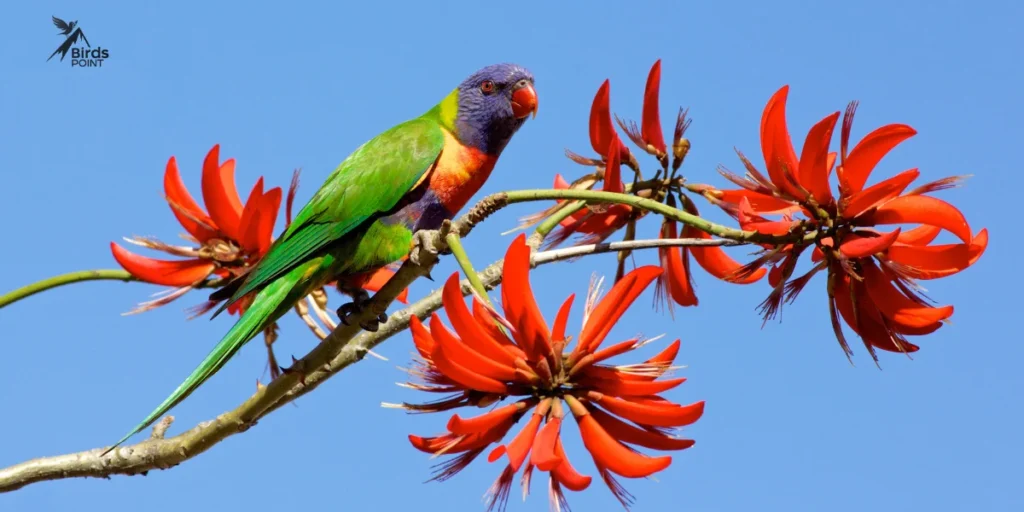
Appearance
- Color: The Rainbow Lorikeet sports a bright mix of green, blue, yellow, and orange feathers. Its colors are arranged in a striking pattern across its body.
- Size: About 10-12 inches (25-30 cm) in length.
- Beak: The beak is short and hooked, designed for feeding on nectar and fruits.
Habitat
Rainbow Lorikeets are found in a variety of habitats, including coastal forests, woodlands, and urban areas. They thrive in environments with abundant flowering plants.
Diet
Their diet primarily consists of nectar from flowers, but they also eat fruits, seeds, and pollen. Their specialized tongues are adapted to extract nectar from flowers.
Behavior
Rainbow Lorikeets are social and noisy birds, often seen in flocks. They are known for their acrobatic flight and playful behavior. They also have a distinctive, high-pitched call.
Conservation Status
The Rainbow Lorikeet is classified as Least Concern by the IUCN. They are widespread and adaptable, though they face threats from habitat loss and trapping in some areas.
| Feature | Details |
|---|---|
| Scientific Name | Trichoglossus haematodus |
| Weight | 3.5-5.5 oz (100-155 g) |
| Wingspan | 8-12 inches (20-30 cm) |
| Length | 9-12 inches (23-30 cm) |
| Beak | Short and curved |
| Lifespan | 10-15 years |
9. Kingfisher
Description
Kingfishers are a diverse group of birds known for their brilliant plumage and hunting skills. They are found across the world, from tropical rainforests to temperate regions.
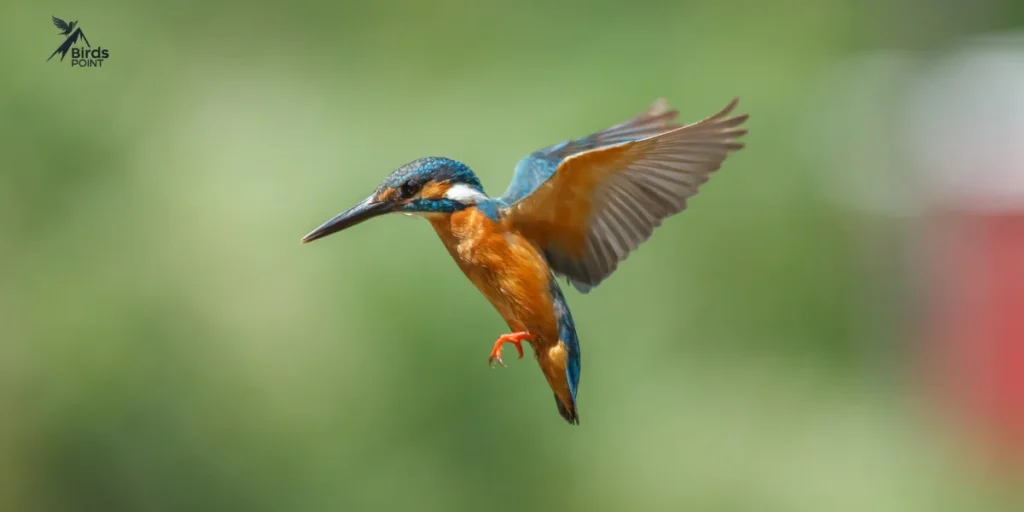
Appearance
- Color: Kingfishers come in a range of colors, including bright blues, greens, and oranges. Their plumage is often iridescent, reflecting light in dazzling ways.
- Size: Sizes vary by species, from small (around 6 inches or 15 cm) to large (up to 18 inches or 45 cm).
- Beak: They have long, pointed beaks adapted for catching fish and other prey.
Habitat
Kingfishers are typically found near water sources such as rivers, lakes, and coastal areas. They require clear, fish-rich waters for hunting.
Diet
Their diet mainly consists of fish, but they also eat insects, amphibians, and small reptiles. Kingfishers dive into the water to catch their prey, using their sharp beaks to snatch it up.
Behavior
Kingfishers are known for their spectacular diving skills and distinctive calls. They often perch on branches or rocks near water, scanning for prey. Their hunting technique involves a swift plunge into the water to catch fish.
Conservation Status
Kingfishers vary in conservation status by species. Many are classified as Least Concern, but habitat destruction and pollution can impact local populations. Conservation efforts focus on preserving their aquatic habitats and reducing pollution.
| Feature | Details |
|---|---|
| Scientific Name | Various species |
| Weight | 2-5 oz (60-150 g) |
| Wingspan | 8-10 inches (20-25 cm) |
| Length | 7-10 inches (18-25 cm) |
| Beak | Long and pointed |
| Lifespan | 10-15 years |
10. American Flamingo
Description
The American Flamingo is known for its striking pink plumage and long, slender legs. Native to the Caribbean and parts of South America, this bird is a symbol of tropical beauty.
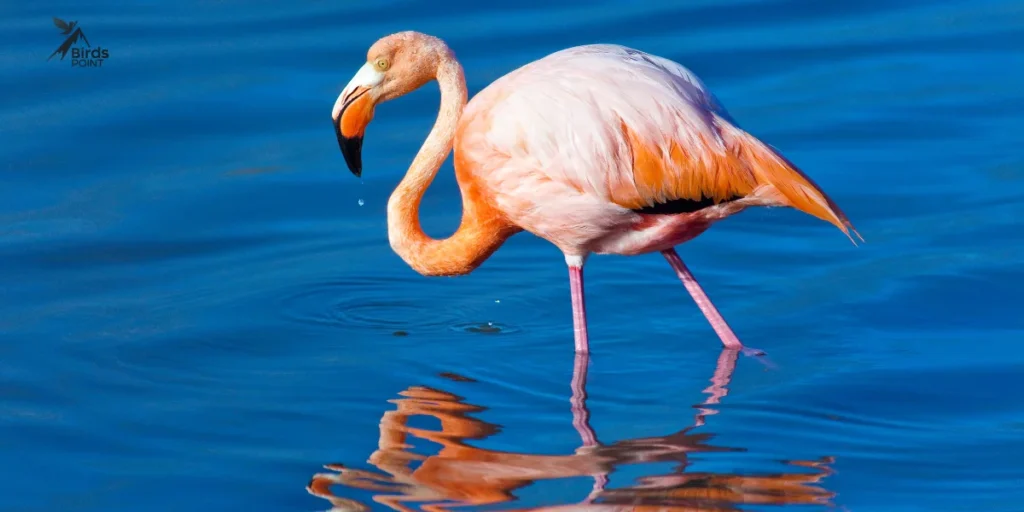
Appearance
- Color: Adult flamingos are primarily pink, with variations in shade depending on diet. Their feathers range from pale pink to bright coral.
- Size: Approximately 3.3 to 4.6 feet (1 to 1.4 meters) in height.
- Beak: The beak is large, curved, and adapted for filtering food from water.
Habitat
American Flamingos inhabit shallow coastal lagoons, salt flats, and brackish lakes. They prefer areas with abundant food resources and minimal disturbance.
Diet
Their diet consists mainly of algae, crustaceans, and small aquatic organisms. The pink color of their feathers comes from the carotenoids in their diet, which are broken down in the digestive system.
Behavior
Flamingos are known for their distinctive feeding technique, where they use their beaks to filter food from the water. They also perform elaborate courtship displays, including synchronized dancing and calling.
Conservation Status
The American Flamingo is classified as Least Concern by the IUCN. However, they face threats from habitat loss and pollution. Conservation efforts focus on protecting their breeding sites and managing human impacts.
| Feature | Details |
|---|---|
| Scientific Name | Phoenicopterus ruber |
| Weight | 3.3-9 lbs (1.5-4 kg) |
| Wingspan | 40-60 inches (100-155 cm) |
| Length | 35-50 inches (90-130 cm) |
| Beak | Long, curved, and filter-feeding |
| Lifespan | 20-30 years |
11. Painted Bunting
Description
The Painted Bunting is a small passerine bird native to North America. Known for its stunning array of colors, this bird is often found in southeastern parts of the United States and Mexico.
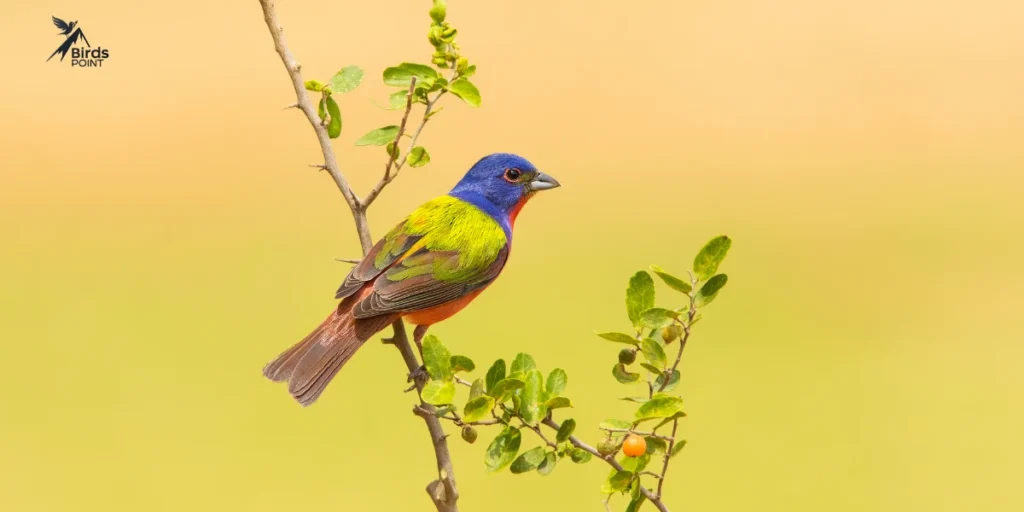
Appearance
- Color: Males display a mix of vibrant blue, green, red, and yellow plumage. Females and juveniles are more subdued in color, with green and brown tones.
- Size: About 4.5 to 5 inches (11-13 cm) in length.
- Beak: The beak is short and conical, suited for eating seeds and insects.
Habitat
Painted Buntings prefer shrubby areas, woodlands, and open forests. They are often found in habitats with dense vegetation and plenty of cover.
Diet
Their diet consists of seeds, insects, and small fruits. They forage on the ground and in shrubs, using their strong beaks to crack seeds and capture insects.
Behavior
Painted Buntings are known for their beautiful songs and colorful plumage. Males are particularly striking during the breeding season when they are most visible. They are often seen in pairs or small groups.
Conservation Status
The Painted Bunting is classified as Near Threatened by the IUCN. Habitat loss and the pet trade are significant threats. Conservation efforts are focused on habitat preservation and monitoring population trends.
| Feature | Details |
|---|---|
| Scientific Name | Passerina ciris |
| Weight | 0.5-0.7 oz (14-20 g) |
| Wingspan | 8-10 inches (20-25 cm) |
| Length | 4.5-5.5 inches (11-14 cm) |
| Beak | Short and conical |
| Lifespan | 5-10 years |
12. Paradise Tanager
Description
The Paradise Tanager, native to the tropical forests of Central and South America, is a small, brilliantly colored bird. Its vibrant plumage and striking appearance make it a favorite among bird watchers.
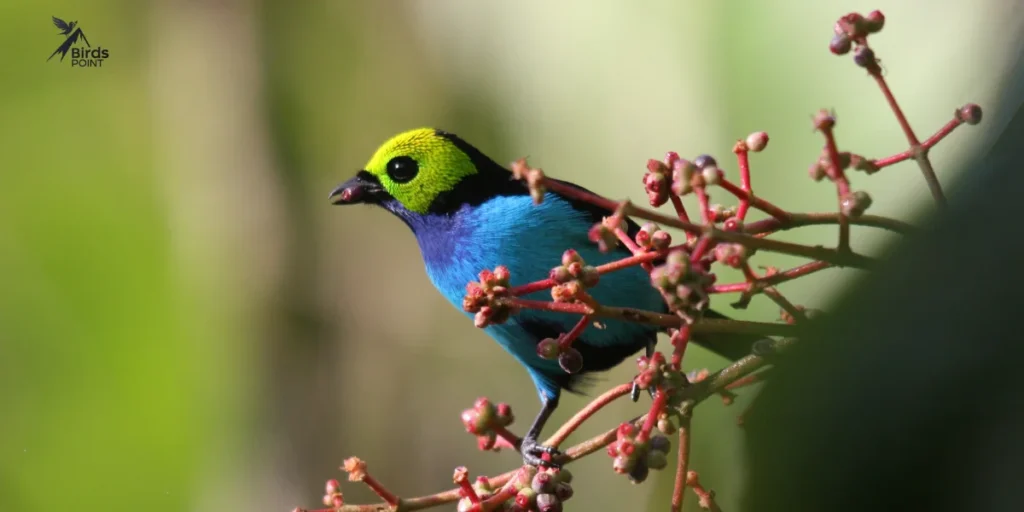
Appearance
- Color: Males display a dazzling mix of blue, green, yellow, and black feathers. Females are less colorful but still possess a beautiful mix of hues.
- Size: About 5.5 inches (14 cm) in length.
- Beak: The beak is short and conical, suitable for feeding on fruit and insects.
Habitat
Paradise Tanagers inhabit the humid, tropical rainforests of the Amazon Basin. They prefer dense forest environments with abundant fruiting trees.
Diet
Their diet primarily consists of fruit, insects, and small invertebrates. They forage in the trees, using their strong beaks to extract food.
Behavior
Paradise Tanagers are known for their lively and active behavior. They are often seen in small flocks and are highly social. Their vibrant plumage is used to attract mates and establish territory.
Conservation Status
The Paradise Tanager is classified as Least Concern by the IUCN. However, habitat loss due to deforestation poses a threat. Conservation efforts are focused on preserving their rainforest habitats.
| Feature | Details |
|---|---|
| Scientific Name | Tangara chilensis |
| Weight | 1.1-1.8 oz (30-50 g) |
| Wingspan | 8-10 inches (20-25 cm) |
| Length | 5-6 inches (12-15 cm) |
| Beak | Short and conical |
| Lifespan | 5-10 years |
13. Wilson’s Bird-of-Paradise
Description
Wilson’s Bird-of-Paradise is one of the most elaborate and colorful birds of paradise. Native to the islands of Indonesia, this bird is known for its extravagant plumage and unique courtship displays.
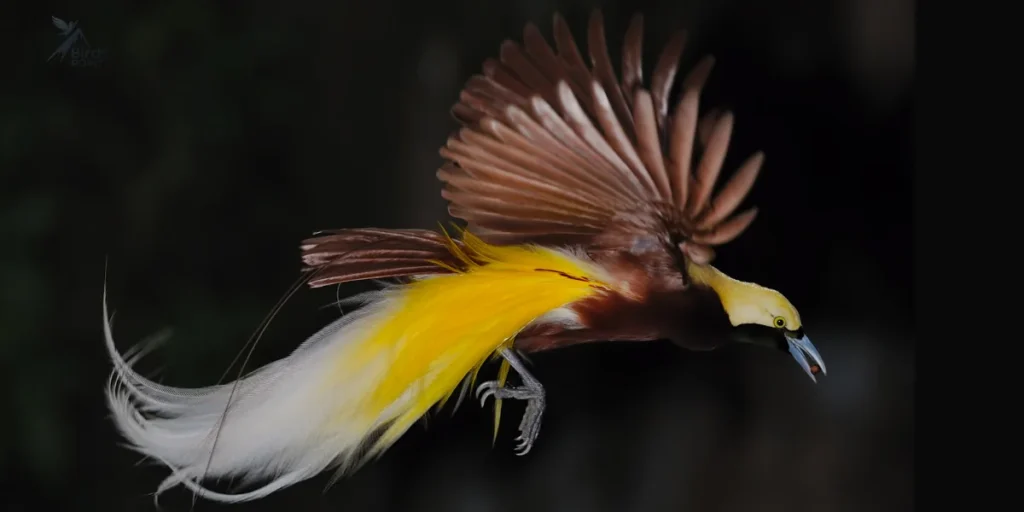
Appearance
- Color: Males have a complex mix of red, blue, green, and yellow feathers. They also possess long, ornate tail feathers and intricate patterns.
- Size: About 10 inches (25 cm) in length.
- Beak: The beak is short and conical, adapted for feeding on insects and fruit.
Habitat
Wilson’s Bird-of-Paradise is found in the lowland forests of Indonesia, particularly on the islands of Sulawesi and surrounding areas. They prefer dense, tropical forests with ample cover.
Diet
Their diet consists of insects, fruits, and small invertebrates. They forage in the undergrowth and canopy layers of the forest.
Behavior
Males are known for their elaborate courtship displays, which include intricate dances and calls. Their vibrant plumage is used to attract females and establish territory.
Conservation Status
Wilson’s Bird-of-Paradise is classified as Endangered by the IUCN. Habitat loss and the pet trade pose significant threats. Conservation efforts focus on protecting their forest habitats and managing the pet trade.
| Feature | Details |
|---|---|
| Scientific Name | Cicinnurus respublica |
| Weight | 0.6-0.8 oz (17-23 g) |
| Wingspan | 6-8 inches (15-20 cm) |
| Length | 5-6 inches (12-15 cm) |
| Beak | Short and slender |
| Lifespan | 5-10 years |
14. Indian Roller
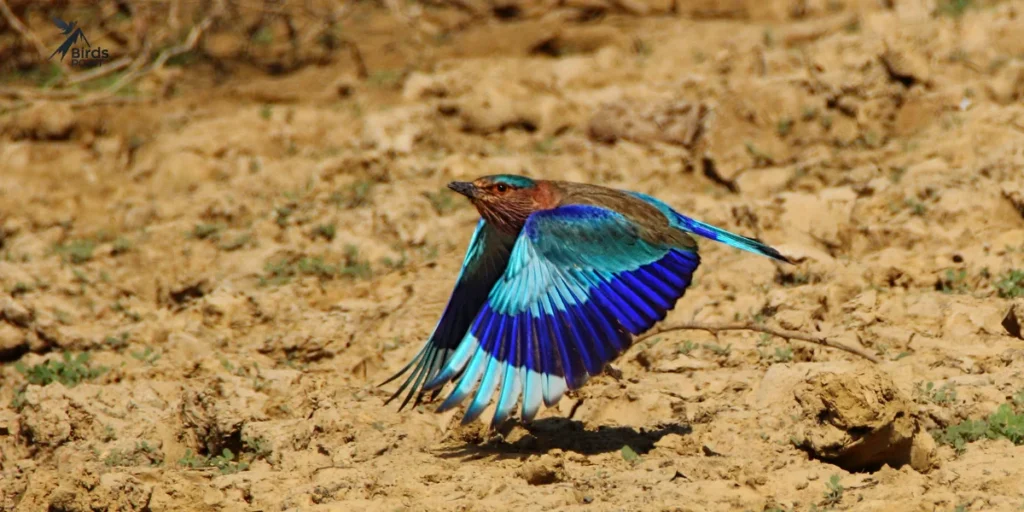
Description
The Indian Roller is a brightly colored bird native to the Indian subcontinent. Its vibrant plumage and distinctive appearance make it a popular bird among enthusiasts.
Appearance
- Color: The Indian Roller features a striking mix of blue, green, and brown plumage. Males are particularly vibrant during the breeding season.
- Size: About 12-14 inches (30-35 cm) in length.
- Beak: The beak is short and pointed, suited for catching insects and small prey.
Habitat
Indian Rollers are found in open fields, grasslands, and agricultural areas across the Indian subcontinent. They prefer areas with scattered
trees and open spaces.
Diet
Their diet includes insects, small reptiles, and occasionally small mammals. They are known for their hunting skills and often perch on elevated spots to scan for prey.
Behavior
Indian Rollers are known for their colorful flight displays and distinctive calls. They are often seen perched on power lines or trees, where they wait for prey.
Conservation Status
The Indian Roller is classified as Least Concern by the IUCN. They are widespread and adaptable, though habitat loss can impact local populations.
| Feature | Details |
|---|---|
| Scientific Name | Coracias benghalensis |
| Weight | 4-5 oz (110-140 g) |
| Wingspan | 16-20 inches (40-50 cm) |
| Length | 12-14 inches (30-35 cm) |
| Beak | Medium-sized and strong |
| Lifespan | 10-15 years |
15. Northern Cardinal
Description
The Northern Cardinal is a well-known bird native to North and Central America. Its bright red plumage and distinctive crest make it a favorite among bird watchers and nature enthusiasts.
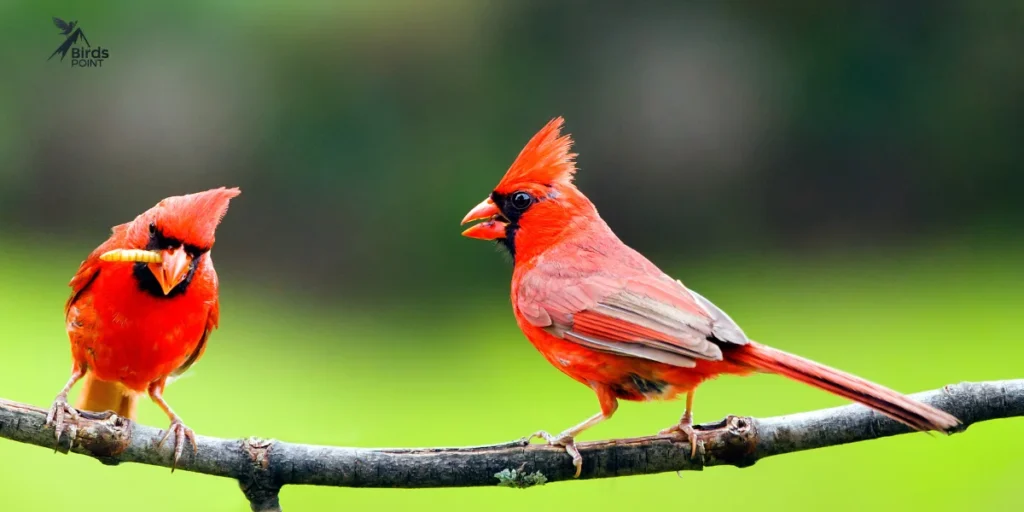
Appearance
- Color: Males are vivid red with a black mask around the face and a crest on the head. Females are more subdued, with brownish-gray plumage and a slight crest.
- Size: About 8.3-9.3 inches (21-23.5 cm) in length.
- Beak: The beak is bright orange and conical, ideal for cracking seeds.
Habitat
Northern Cardinals are found in a variety of habitats, including woodlands, gardens, and shrublands. They are common across the eastern United States and parts of Mexico and Central America.
Diet
Their diet mainly consists of seeds, fruits, and insects. They are known for their ability to crack seeds with their strong beaks and enjoy a variety of fruits.
Behavior
Northern Cardinals are known for their beautiful songs and territorial behavior. Males sing to establish their territory and attract mates. They are often seen in pairs and are highly adaptable to urban environments.
Conservation Status
The Northern Cardinal is classified as Least Concern by the IUCN. They are widespread and common, though habitat loss can impact some local populations. Conservation efforts focus on maintaining diverse habitats and managing human impacts.
| Feature | Details |
|---|---|
| Scientific Name | Cardinalis cardinalis |
| Weight | 1.5-2.5 oz (42-70 g) |
| Wingspan | 9-12 inches (23-30 cm) |
| Length | 8-9 inches (20-23 cm) |
| Beak | Thick and conical |
| Lifespan | 3-15 years |
These 15 colorful birds represent just a fraction of the incredible diversity found in the avian world. Their stunning plumage and unique behaviors not only contribute to the beauty of their respective habitats but also offer a glimpse into the rich tapestry of life on our planet.
Conclusion
The 15 most colorful birds featured in this guide are a testament to the incredible artistry of nature. From the dazzling plumage of the Scarlet Macaw to the vibrant feathers of the Northern Cardinal, these birds captivate our imagination and bring a splash of color to our world.
Their striking appearances are not just a feast for the eyes but also play important roles in their ecosystems, from attracting mates to deterring predators. Each bird, with its unique patterns and colors, contributes to the rich tapestry of wildlife and highlights the diversity of avian species.
By learning about and appreciating these beautiful birds, we gain a greater understanding of the natural world and the need to protect it. Conservation efforts are crucial to ensure that these magnificent creatures continue to thrive and inspire awe in people around the globe.
In celebrating these colorful birds, we also reaffirm our commitment to preserving their habitats and supporting the broader efforts to maintain biodiversity. Their beauty is a reminder of the wonders of nature and the importance of safeguarding our planet’s treasures for future generations.
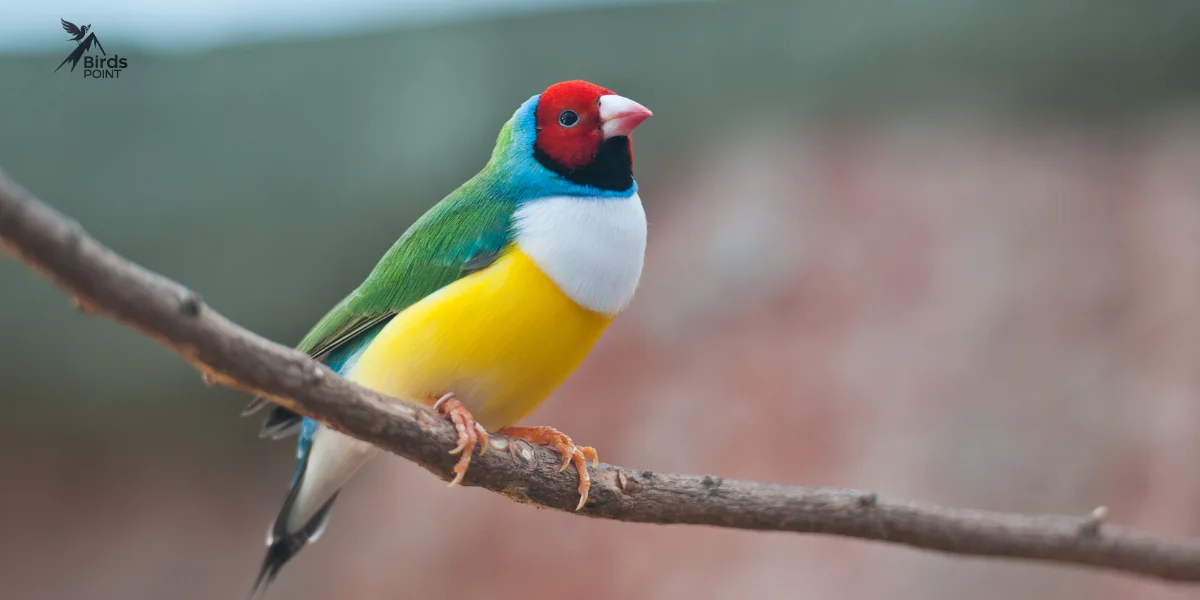
1 thought on “Top 15 Most Colorful Birds in the World (With Pictures)”